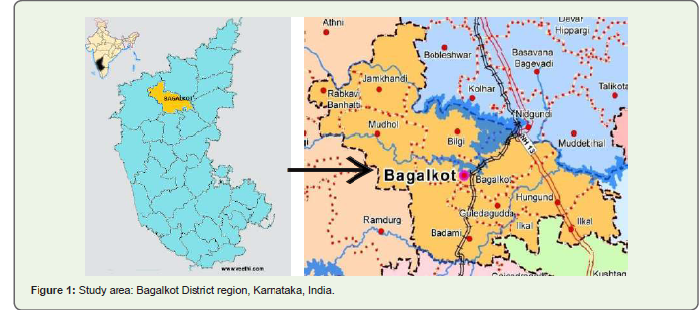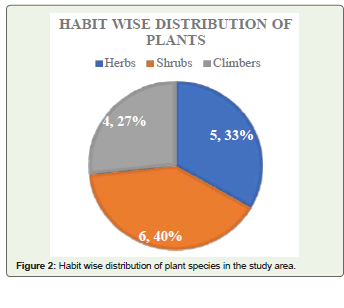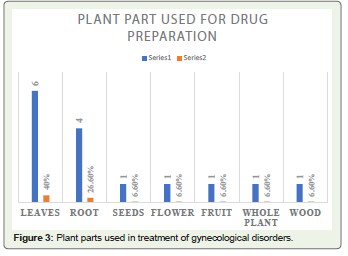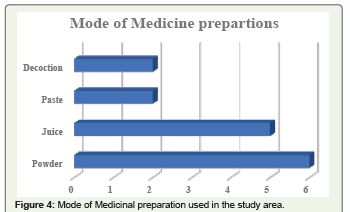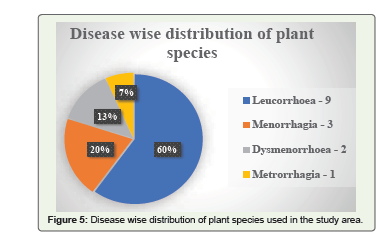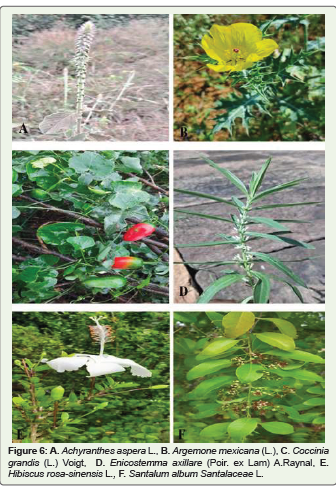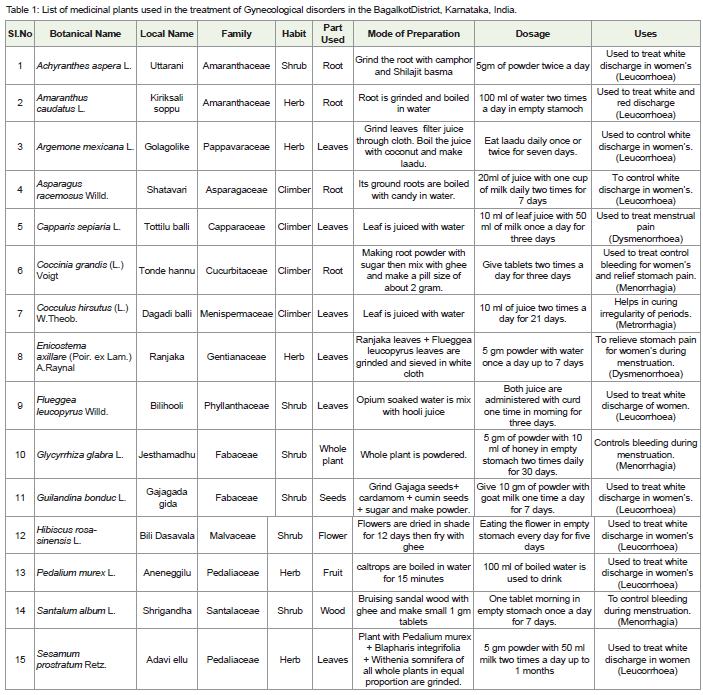Research Article
Ethnomedicinal Plants Used in the Treatment of Gynecological Disorders by the Traditional Health Practitioners in Bagalkot District, Karnataka, India
Vijaymahantesh Gobbi and Kotresha Katrahalli*
Taxonomy and Floristic Laboratory, Department of UG, PG and Research in Botany, Karnatak University’s, Karnataka Science College, Dharwad, India
*Corresponding author: Kotresha Katrahalli, Taxonomy and Floristic Laboratory, Department of UG, PG and Research in Botany, Karnatak University’s, Karnataka Science College, Dharwad, India. Email: kotresh_sk@yahoo.com g.vijay919@gmail.com
Copyright: © Gobbi V, et al. 2023. This is an open-access article distributed under the Creative Commons Attribution License, which permits unrestricted use, distribution, and reproduction in any medium, provided the original work is properly cited.
Article Information: Submission: 27/01/2023; Accepted: 24/02/2023; Published: 28/02/2023
Abstract
Gynecological disorder is one of the most severe conditions under reproductive health. So, we investigate and collect information from traditional
practitioners on the use of medicinal plants for treatment of gynecological disorder in Bagalkot district, Karnataka. The field study was carried out during
January 2021 – October 2022. The indigenous knowledge of local traditional healers about the plant species used for medicinal purposes was collected
using a questionnaire by personal interviews during field visits. In the present investigation, 15 plant species, belonging to 15 genera and 12 families used
by the local healers against gynecological problems of the women are documented. Leaves (5) were the most frequently used plant parts and most of the
medicines were prepared in the form of juice and administrated orally. On the basis of fieldwork, it is revealed that the traditional health practitioner’s use the
plant medicine commonly for white discharge (leucorrhea) and irregularity periods (Metrorrhagia) in women’s. The scientific name, family, local name, habit,
part used and mode of their administrations are provided in the table.
Keywords: Medicinal plants; Gynecological disorder; Traditional health practitioner; Bagalkot district
Introduction
Gynecology is a branch of medicine that deals with the condition
of the female reproductive system. An emerging specialty called
ethanol gynecology uses local medicinal plants to treat gynecological
conditions such as abortion, menstruation disorders, leucorrhea,
infertility, and delivery issues. Menstrual disorders, despite playing a
significant role in women’s lives, are sometimes overlooked as serious
health problems that can interfere with women’s daily activities. The
restrictions on analgesics and sanitary facilities lead Indian women
to prefer household spice cabinets or traditional medications [1].
This study concentrated on the traditional remedies that indigenous
women used to manage menstrual discomfort. The traditional health
practitioners in Karnataka’s Bagalkot District are highly known for having a thorough understanding of medicinal plants. This paper attempts to compile useful information about plants used traditionally
by local healers to treat gynecological diseases.
Materials and Method
Study Area: Bagalkote is a city situated in the northern part of
the Indian state of Karnataka. Geographically, it is located at the coordinates
16.18°N 75.7°E, and Situated along the banks of the River
Ghataprabha, it lies at an average elevation of 533 meters above sea
level. It is the head-quarters of bagalkote district. The district consists
of nine C.D. blocks namely Badami, Bagalkote, Bilagi, Hunugund,
Jamakhandi, Mudhol, Ilkal, Guledgudd, and Rabhakavi Banahatti.
[Figure 1].
Ethnobotanical data collection: The present work was carried out in villages of the nine talukas of Bagalkot district, Karnataka.
The extensive studies were conducted during the period January, 2021 to November, 2022 with the help of local informants and local Traditional Health Practitioners (THPs) including males and females
of different age groups, education level and experience of medicinal plants utilization. Plant specimens are to be collected with flower and fruits. The collector number is given to each plant and noted the field
observation in field note book.
To get information from Traditional Health Practitioners, a
questionnaire (Data sheet) must be produced. To keep record of
additional information during interactions, a data sheet including
the Traditional Practitioner’s name, age, occupation, visit date,
knowledge, location, plant family, habit, dosage, and vernacular
names as well as a field study note book are also kept.
Botanical identification:
All the plant specimens collected during
field visits were taxonomically identified with the help of available
floras [2,6]. The correct plant names were verified from International
Plant Names Index [7].Preparation of Herbarium: The collected plant specimens at the
time of field visits were prepared in the form of herbarium as suggested
by Jain and Rao (1997) [8]. To protect against insect and fungal attack
the herbarium sheet are poisoning with 95% ethanol or methylated
spirits (denatured alcohol).
Result and Discussion
The present study revealed that 15 plant species, belonging to 15
genera and 12 families used by the local healers against gynecological
problems of women are documented. Out of 15 plants, the majority of
the species are shrubs (40%), followed by herbs (33%), and climbers
(27%) [Figure 2]. The majority of medications are made from the
following plant parts: leaves (40%), roots (27%), seeds (6.6%), flowers
(6.6%), fruit (6.6%), whole plant (6.6%), and wood (6.6%) [Figure 3].
Traditional medical practitioners frequently rely their diagnoses
on both their own expertise in treating patients’ ailments as well as
details offered by patients about their symptoms. The four types of
medicinal preparations in the current survey were used by grinding
up diverse plant parts into powder(6), extracting juice from plant
parts(5), combining plant parts with water to make a decoction(2),
and plant parts as a paste (2) [Figure 4]. Oral administration of plant
medicine was the most typical method. Out of 15 plant species, 60%
were used to treat Leucorrhoea (white, yellow, or greenish vaginal
discharge), 20% for Menorrhagia (excessive blood flow during
periods), 13% for Dysmenorrhea (abdominal, back, or other types of
pain associated with periods), and 7% for Metrorrhagia (irregularity
of periods) [Figure 5].
Panduranga et al. (2011) [9] reported 37 medicinal plant species
for women diseases. They explained about Sterculia urens, Hybanthus
enneaspermus, Curculigo orhiodes, Dodonaea viscosa etc. are the
most effective medicinal plants to treat women diseases. Vidysagar
and Murthy (2012) [10] reported that 26 medicinal plants for
menstrual disorders belonged to 21 families in an ethnobotanical
survey carried out in Bellary district. They documented Achyranthes
aspera L., Asparagus racemosus L., Hibiscus rosa-sinensis L., and
Leucas aspera (Willd.) Link. as the most effective species against the
menstrual disorders of women in Bellary District. Laddimath and
Srinath Rao (2016) [11] mentioned in their article that Caesalpinia
bunducella Roxb and Withania somnifera (L.) Dunal are the most
Figure 6: A. Achyranthes aspera L., B. Argemone mexicana (L.), C. Coccinia
grandis (L.) Voigt, D. Enicostemma axillare (Poir. ex Lam) A.Raynal, E.
Hibiscus rosa-sinensis L., F. Santalum album Santalaceae L.
effective medicinal plants for treating primary infertility in women.
Ponnaiah et al. (2018) [12]have reported 24 medicinal plants used for
female health issues.They documented Hibiscus rosa sinensis L. and
Pedalium murex L. to treat female health issues. Sahu et al, (2021)
[13] have reported 28 species for the treatment of urogenital ailments.
Jiao M et al. (2022) [14] Screened 93 literatures on the topic
Menstrual disorders in different countries, and analyzed 130 families
and 571 species of plants used by women from different countries and
regions. Among them, 451 are herbs, 178 are trees, 72 are shrubs, 21 are
vines, five are climbers and 37 are of other types. The five main families
are Asteraceae, Lamiaceae, Apiaceae, Fabaceae, and Zingiberaceae,
while the five frequently used plants are Zingiber officinale Roscoe.
(Ginger), Ruta graveolens L. (Common rue), Angelica sinensis
(Oliv.) Diels (Angelica sinensis), Foeniculum vulgare Mill. (Fennel),
and Catharanthus roseus (L.) G. Don (Catharanthus roseus). The
general dosage of these herbs was 3–15 g. Vineeta et al. (2022) [15]
documented a total of 114 ethnogynecoloical plant species from the
retrieved literature of West Bengal, India. They found that Leucorrhea
was treated with the highest number of plant species, and roots were
most frequently used in different gynaecological ailments. Ugiomoh
et al. (2023) [16] revealed that Fabaceae, Malvaceae, and Apocynaceae
are the most recurrent families for the treatment of female infertility
in the Agbor, Ika South, Delta State, Nigeria [Table 1].
Conclusion
In the present study 15 plant species, belonging to 15 genera
and 12 families used by the local healers against gynecological
problems of women are documented. Flueggea leucopyrus Willd.
and Guilandina bonduc L., are the two plant species found in our
study to be mostly used to treat gynecological disorders by traditional
healers. The identification of ethno-medicinal plants used to treat
gynecological disorders is important for the future since it will benefit
both researchers and native populations. The described therapies
required ethno-medicinal plants, photochemical processes, and other
processes.
Acknowledgment
The authors are grateful to all the traditional healers of Bagalkot
for providing the valuable information relevant to this work. The
authors are also thankful to the authorities of Karnatak College
Dharawad and Karnatak University, Dharawad, for providing good
support and facilities. The authors would also like to thank the field
assistants, Mr. Sangamesh Waladunki, Mr. Muttu Kalyani, and Mr.
Shravankumar Kalyani.
References
4. Saldanha CJ (1984) Flora of Karnataka.Vol. I-II. Oxford & IBH Publishing. Co. Pvt. Ltd. New Delhi.

